31 DnD 5e Spell Statistics
Magic is my favorite part of Dungeons and Dragons. From soiling your friend’s pants with Prestidigitation to exploding heads with Psychic Scream, DnD spells are just fun to use.
Beyond the imaginative aspect of DnD spells, I’ve always been impressed with the language used in spell descriptions. Each one is like a little legal document and set of rules unto itself.
That got me thinking — does a lower-level spell take fewer words to explain than a higher-level spell? Do certain classes tend to have wordier spellbooks? And which spell school would offer the toughest curriculum, assuming that word counts are a decent proxy for complexity?
So I did what any normal person would do — I counted the words of every spell description in DnD 5e. Neat; I had all my answers.
But that handful of statistics seemed woefully incomplete. So I made a spreadsheet containing just about every piece of information on every spell in the game and found answers for every other question I could think of. The results are below:
Word Count Statistics
-
There are 477 spells in three main fifth edition Dungeons and Dragons sourcebooks (the Player’s Handbook, Xanathar’s Guide to Everything, and Tasha’s Cauldron of Everything).
-
The total word count of all DnD 5e spell descriptions is 69,019 words. For a person with an average reading speed of 200 words-per-minute, this is about 5 hours and 45 minutes of reading.
-
The average word count of 5e spells is 144.7 words, while the median word count is 120 words.
-
The School of Illusion has the highest average word count (168) in the game, while the School of Divination has the lowest average word count (108).
-
Illusion spells also have the highest median word count (166) in the game, but Abjuration spells have the shortest median word count (84).
-
From cantrips to 9th-level spells, DnD 5e’s magic does get tend to get wordier the more you level up. The only exception is 8th-level spells, which have a shorter average word count than 7th-level spells.
-
Warlocks have the most complex spell list, using average spell word count as a proxy for complexity. The average Warlock spell is about 155 words long, 7% more than the average spell in DnD.
Paladins, with a 106-word average spell book, are the least complex spellcasters in 5e. Their average spell is roughly 27% shorter than the gamewide average.
-
However, if we look at median word count, Wizards, at 126 words, are the most complex class.
Rangers, with a median spell word count of 81.5, are the least complex class by this metric.
-
Invulnerability is the shortest spell in DnD 5e at just 10 words. Prismatic Wall is the game’s longest spell at 706 words. Strangely enough, both are 9th-level Abjuration spells.
-
Evocation spells are the most common in DnD 5e, comprising 21.2% of the game’s spells. Illusion, with just 6.5% spell representation, is the least common type of magic in Dungeons and Dragons.
-
Fire is the most common damage type of all of DnD 5e’s spells. It accounts for 13.5% of all damage-dealing spells. Necrotic, Radiant, and Bludgeoning damage all tie for second place with 11.2% apiece.
-
Meteor Swarm is the most damage ability in Dungeons and Dragons 5e. On a failed Dexterity save, it deals a total of 140 damage (70 fire and 70 bludgeoning).
-
The Restrained condition is the most common one caused by spells in 5e. Poison is the least common spell-caused condition, caused by only one spell (Ray of Sickness).
-
Dexterity saving throws are the most common ones forced by DnD 5 spells, followed by Constitution and Wisdom. Intelligence saves are the least common.
-
1st- and 2nd- level spells are the most common in the game, with 73 apiece. There’s a noticeable dip in 4th-level spell options, but other than that, more complex spells are rarer than simple spells. Except for, of couse, cantrips, which see about as much representation as 6th-level spells.
-
Spells with a range of 60 feet are the most common in DnD 5e. Spells with a range of Touch are the next most common, followed by Self-targeted spells.
-
Spells that require vocal, somatic, and material components make up 48.6% of DnD 5e’s spells. Spells that just require verbal and somatic components are the next most popular at 31.7%
Spells that require only somatic and material components are the rarest, comprising just 2.1% of spells.
-
Necromancy is the most expensive school of magic in DnD 5e, with a total cost of 32,600 gp. 28,900 gp of that is consumed, but that’s mostly from True Resurrection — the most expensive spell in game — which consumees 25,000 gp worth of diamonds.
-
Enchantment is the least expensive school of magic in DnD 5e. O Enchantment spells have a material component with a cost requirement, and 0 Enchantment spells consume the material component.
-
However, Abjuration has the highest number of spells that consume the material component — 13. That’s also the highest rate of any spell school, as 25% of Abjuration spells consume a material. 3 of those spells don’t have a cost requirement, at least.
-
Conjuration spells have the highest number of spells with a material cost requirement — 20. That’s 23% of all Conjuration spells.
However, Abjuration has the highest rate of spells with a cost requirement — 29%.
-
Over 1 in 4 DnD 5e spells are instantaneous spells, making it the most common duration in DnD 5e. 1 minute, 1 hour, and 1 round spell durations are the next runners up.
-
Unsurpirsingly, Wizards have access to more of the game’s spells than any other class. Their spell list contains 65% of the 5e’s spells, and with enough time and research, they can make use of a huge portion of that number.
Paladins, with access to just over 10% of 5e’s spells, are the least magically diverse spellcasters in the DnD universe.
-
Utility spells are the most common in DnD 5e — but that’s partly due to my broad definition of “Utility.” 34% of DnD 5e spells deal damage, and shockingly few can heal players. Spells that cause debuffs are about 37% more common than spells that provide allies buffs.
-
181 spells in DnD 5e are area of effect spells (like Faerie Fire) or affect multiple creatures (like Bless).
-
165 spells from 5e can be upcast — about 35% of the game’s spells.
-
There are 218 concentration spells in DnD 5e — 45.7% of all spells.
-
There are 32 ritual spells in DnD 5e. 40.6% of ritual spells belong to the School of Divination.
-
The Player’s Handbook started the fifth edition of Dungeons and Dragons with 361 spells. Xanathar’s Guide to Everything added 95 spells, and Tasha’s Cauldron of Everything introduced another 21 (11 of which belonged to the School of Conjuration).
-
Evocation spells are represented at the highest rate in the Player’s Handbook, Transmutation spells in Xanathar’s, and Conjuration spells in Tasha’s.
-
157 spells in DnD 5e have been around since the first edition of Dungeons and Dragons.
| Spell School | # of Spells | Average Word Count | Median Word Count | Longest Spell | Shortest Spell | % of Total Spells |
|---|---|---|---|---|---|---|
| Abjuration | 52 | 151 | 84 | Prismatic Wall (706) | Invulnerability (10) | 10.90% |
| Conjuration | 87 | 168 | 149 | Teleport (577) | Misty Step (19) | 18.24% |
| Divination | 32 | 108 | 99 | Detect Thoughts (350) | See Invisibilty (30) | 6.71% |
| Enchantment | 42 | 148 | 125 | Antipathy/Sympathy (414) | Power Word Kill (38) | 8.81% |
| Evocation | 101 | 122 | 102 | Bigby’s Hand (447) | Divine Favor (23) | 21.17% |
| Illusion | 31 | 168 | 166 | Phantasmal Force (320) | Greater Invisibility (30) | 6.50% |
| Necromancy | 38 | 144 | 109 | Magic Jar (405) | Spare The Dying (23) | 7.97% |
| Transmutation | 94 | 147 | 131 | Control Water (551) | Jump (14) | 19.71% |
Gameplay Statistics
| Damage Type | Number of Spells |
|---|---|
| Acid | 7 |
| Bludgeoning | 20 |
| Cold | 14 |
| Elemental | 10 |
| Fire | 24 |
| Force | 12 |
| Lightning | 7 |
| Necrotic | 20 |
| Physical | 2 |
| Piercing | 9 |
| Poison | 4 |
| Psychic | 18 |
| Radiant | 20 |
| Slashing | 3 |
| Thunder | 8 |
Top Ten Most Damaging Abilities in DnD 5e*
| Spell Name | Average Damage |
|---|---|
| Meteor Swarm | 140 |
| Disintegrate | 75 |
| Blade Of Disaster | 67.5 |
| Finger Of Death | 61.5 |
| Symbol | 55 |
| Abi-Dalzim’s Horrid Wilting | 54 |
| Harm | 49 |
| Psychic Scream | 49 |
| Chain Lightning | 45 |
| Incendiary Cloud | 45 |
| Condition | # of Spells |
|---|---|
| Blinded | 15 |
| Charmed | 10 |
| Deafened | 4 |
| Frightened | 9 |
| Incapacitated | 6 |
| Invisibility | 3 |
| Paralyzed | 2 |
| Petrified | 2 |
| Poisoned | 1 |
| Prone | 13 |
| Restrained | 16 |
| Stunned | 6* |
| Unconscious | 6** |
**Astral Projection and Dream of the Blue Veil are self-inflicted
| Saving Throw | # of Spells |
|---|---|
| Constitution | 51 |
| Wisdom | 50 |
| Strength | 22 |
| Dexterity | 64 |
| Charisma | 13 |
| Intelligence | 10 |
Most schools of magic follow this same pattern:
| Component | Number of Spells That Require It |
|---|---|
| Vocal | 451 (95%) |
| Somatic | 420 (88%) |
| Material | 253 (53%) |
| School Of Magic | Material Consumed | Material Cost Requirement | Total Material Cost | Consumed Material Cost |
|---|---|---|---|---|
| Abjuration | 13 | 15 | 5,685 gp | 3,075 gp |
| Conjuration | 4 | 20 | 16,979.1 gp | 1,560 gp |
| Divination | 2 | 7 | 1,375 gp | 50 gp |
| Enchantment | 0 | 0 | 0 gp | 0 gp |
| Evocation | 2 | 9 | 4,450.2 gp | 1,050 gp |
| Illusion | 1 | 3 | 1,530 gp | 1,500 gp |
| Necromancy | 6 | 12 | 32,600 gp | 28,900 gp |
| Transmutation | 4 | 6 | 10,000 gp | 7,000 gp |
Schools of Magic: Representation by Class
| Spell School | Bard | Cleric | Druid | Paladin | Ranger | Sorcerer | Warlock | Wizard | Artificer |
|---|---|---|---|---|---|---|---|---|---|
| Abjuration | 12 | 25 | 15 | 16 | 10 | 11 | 10 | 28 | 15 |
| Conjuration | 9 | 12 | 31 | 4 | 14 | 31 | 27 | 55 | 10 |
| Divination | 17 | 16 | 14 | 5 | 11 | 9 | 8 | 18 | 5 |
| Enchantment | 33 | 7 | 10 | 6 | 2 | 22 | 19 | 27 | 0 |
| Evocation | 16 | 23 | 26 | 13 | 4 | 49 | 15 | 62 | 15 |
| Illusion | 19 | 1 | 2 | 0 | 1 | 16 | 11 | 30 | 5 |
| Necromancy | 7 | 19 | 4 | 3 | 0 | 9 | 18 | 28 | 3 |
| Transmutation | 21 | 12 | 51 | 3 | 16 | 47 | 17 | 63 | 27 |
| Total Spells | 134 | 115 | 153 | 50 | 58 | 194 | 125 | 311 | 80 |
Spell Schools as a Percentage of Class Spell Lists
| Spell School | Bard | Cleric | Druid | Paladin | Ranger | Sorcerer | Warlock | Wizard | Artificer |
|---|---|---|---|---|---|---|---|---|---|
| Abjuration | 9% | 21.7% | 9.8% | 32% | 17.2% | 5.7% | 8% | 9% | 18.8% |
| Conjuration | 6.7% | 10.4% | 20.3% | 8% | 24.1% | 16% | 21.6% | 17.7% | 12.5% |
| Divination | 12.7% | 13.9% | 9.2% | 10% | 19% | 4.6% | 6.4% | 5.8% | 6.3% |
| Enchantment | 24.6% | 6.1% | 6.5% | 12% | 3.5% | 11.3% | 15.2% | 8.7% | 0% |
| Evocation | 11.9% | 20% | 17% | 26% | 6.9% | 25.3% | 12% | 19.9% | 18.8% |
| Illusion | 14.2% | 0.9% | 1.3% | 0% | 1.7% | 8.3% | 8.8% | 9.7% | 6.3% |
| Necromancy | 5.2% | 16.5% | 2.6% | 6% | 0% | 4.6% | 14.4% | 9% | 3.8% |
| Transmutation | 15.7% | 10.4% | 33.3% | 6% | 27.6% | 24.2% | 13.6% | 20.3% | 33.8% |
| Spell School | Damage | Heal | Buff | Debuff | Utility |
|---|---|---|---|---|---|
| Abjuration | 6 | 4 | 31 | 11 | 10 |
| Conjuration | 31 | 2 | 1 | 13 | 58 |
| Divination | 1 | 0 | 6 | 2 | 24 |
| Enchantment | 9 | 0 | 2 | 34 | 5 |
| Evocation | 71 | 9 | 4 | 25 | 39 |
| Illusion | 7 | 0 | 5 | 10 | 16 |
| Necromancy | 15 | 9 | 4 | 10 | 14 |
| Transmutation | 22 | 3 | 34 | 14 | 50 |
| Total | 162 | 27 | 87 | 119 | 216 |
Rulebook and Edition Statistics
| Spell School | PHB | XGtE | TCoE |
|---|---|---|---|
| Abjuration | 12.5% | 6.3% | 4.8% |
| Conjuration | 16.3% | 17.9% | 52.4% |
| Divination | 8.3% | 2.1% | 0% |
| Enchantment | 9.4% | 6.3% | 9.5% |
| Evocation | 20.5% | 24.2% | 19.1% |
| Illusion | 7.8% | 3.2% | 0% |
| Necromancy | 7.5% | 9.5% | 9.5% |
| Transmutation | 17.7% | 30.5% | 4.8% |
| School of Magic | # of 1st Edition Spells | % of Spells From 1st Edition |
|---|---|---|
| Abjuration | 14 | 27% |
| Conjuration | 25 | 29% |
| Divination | 15 | 47% |
| Enchantment | 17 | 40% |
| Evocation | 29 | 29% |
| Illusion | 15 | 48% |
| Necromancy | 9 | 24% |
| Transmutation | 33 | 35% |
| Total | 157 | 33% |
Methodology
All data is taken from the three main fifth edition rulebooks (Player’s Handbook, Xanathar’s Guide to Everything, and Tasha’s Cauldron of Everything).
Word counts do not include the spell name, level, school, casting time, range, components, or duration. Nor do they include the stat blocks of any summoned or conjured creatures. They also do not include the words “At Higher Levels” for spells that can be upcast. Word counts do, however, include all text included in charts, including numbers.
One statistic from above is somewhat subjective: spell types (damage, heal, buff, debuff, utility). I tried to take a common-sense approach to what category each spell falls into and limited each spell to two types. Hopefully, these spell classifications at least prove useful for relative comparisons between spell schools if nothing else.
As a final disclaimer, I did all of this by hand, so there are almost certainly some small errors in my work — I’m only human.
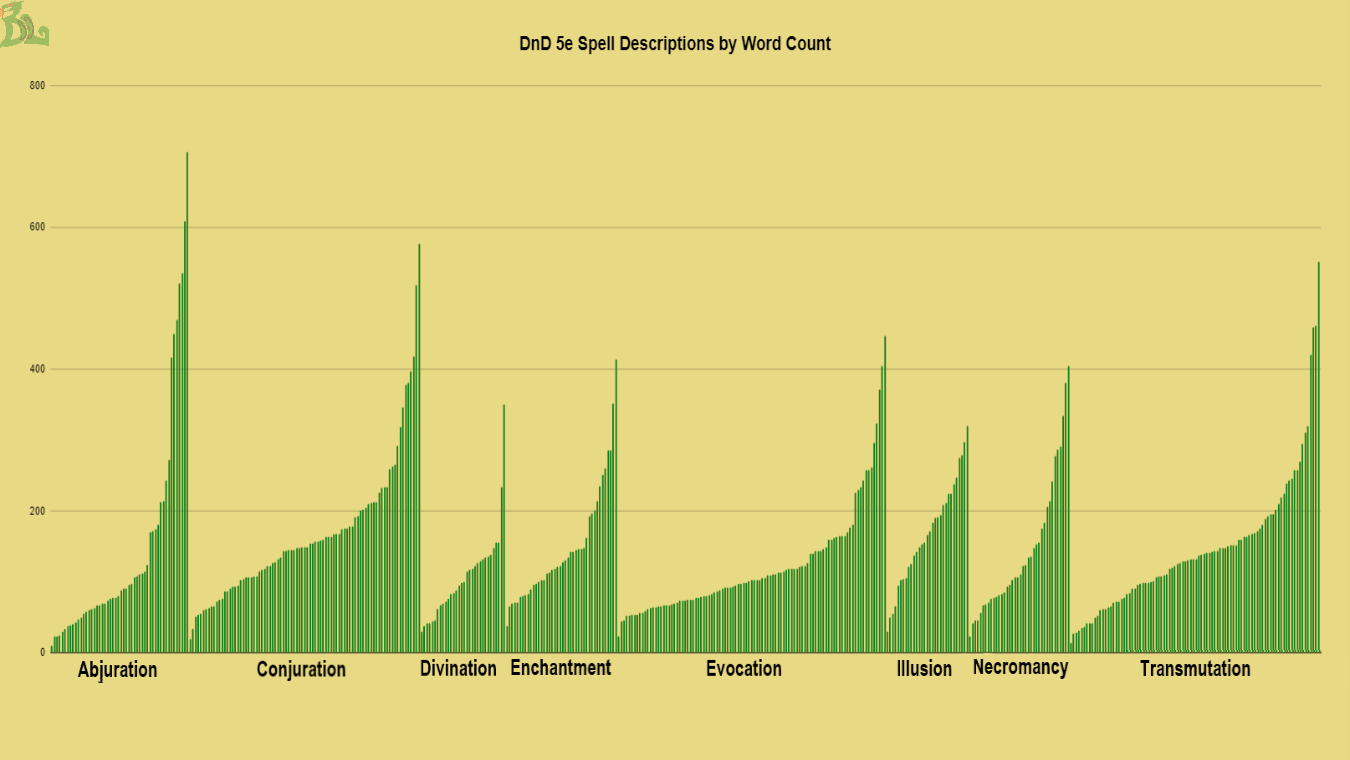
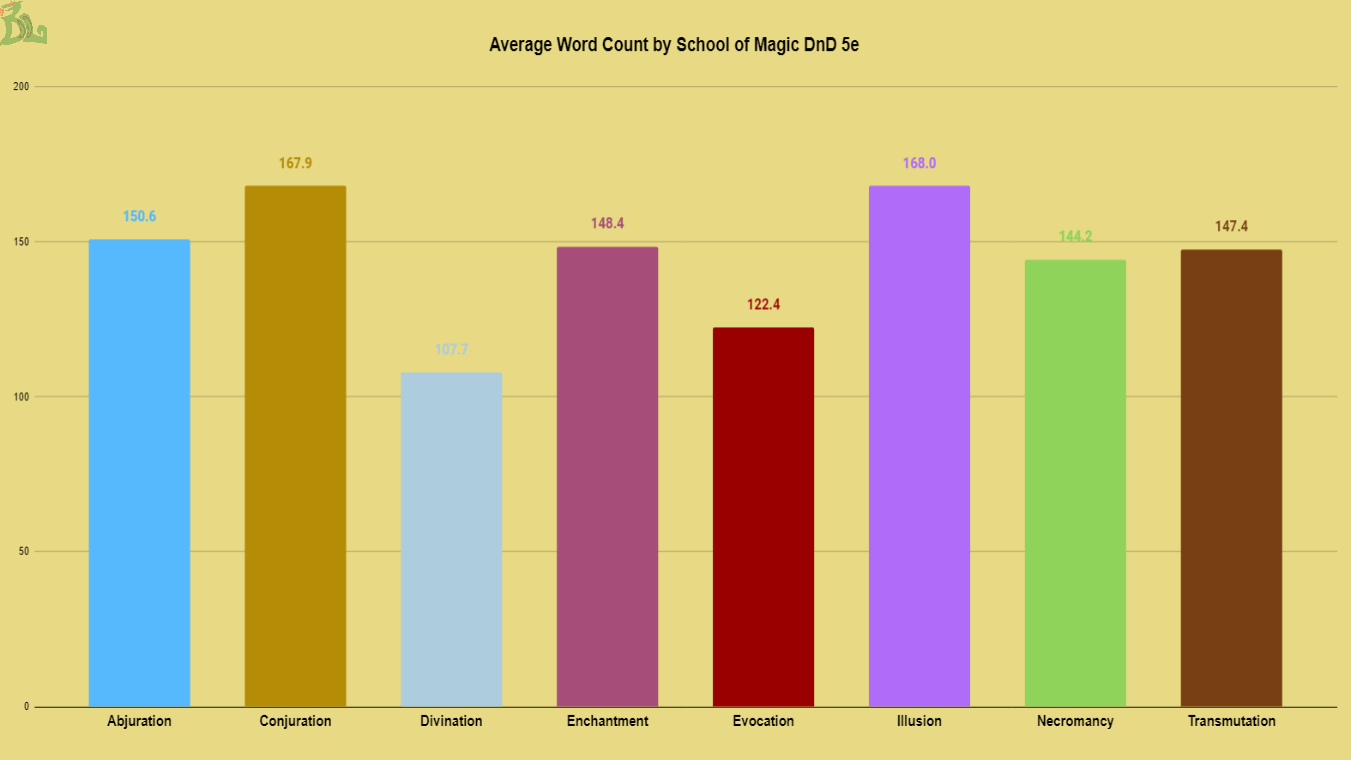
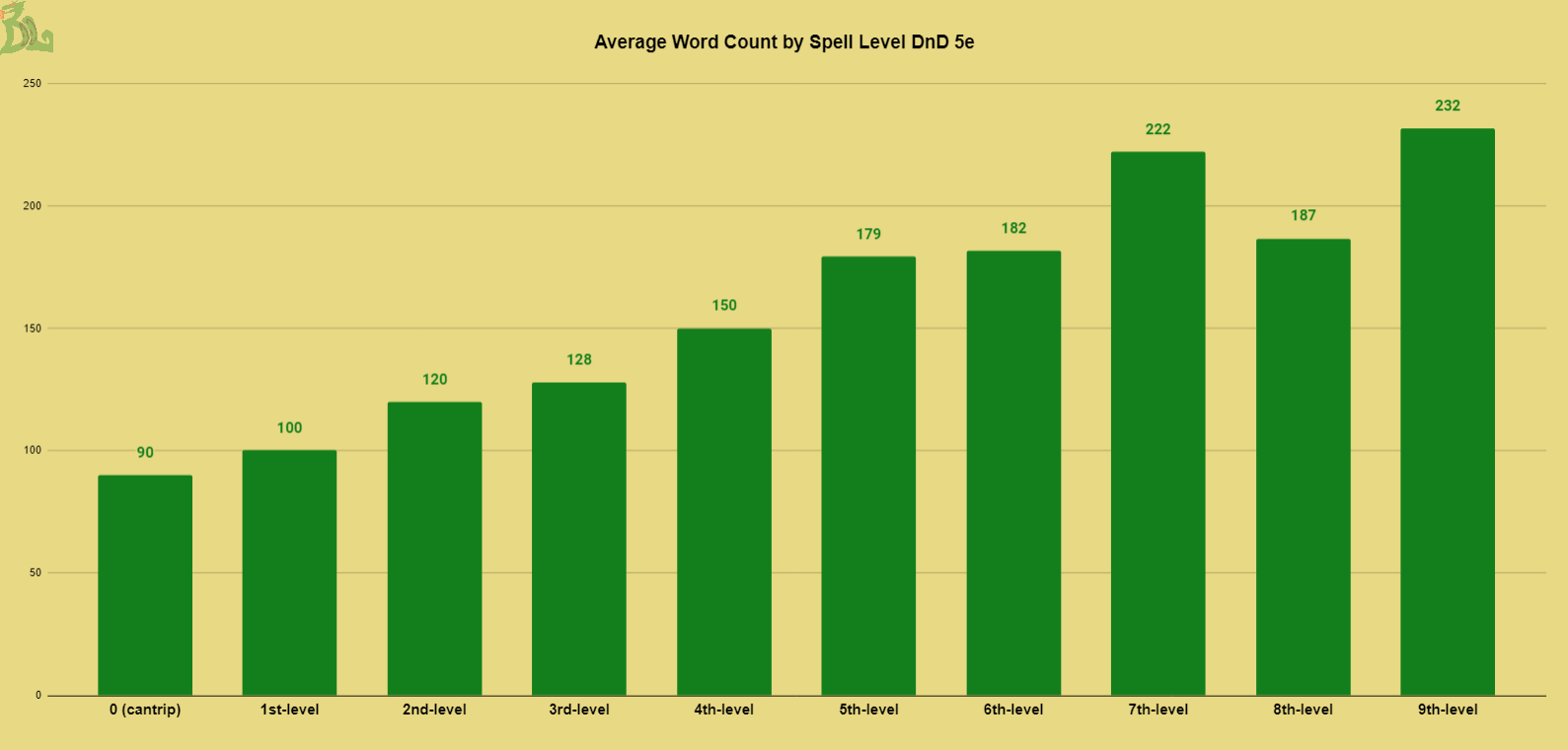
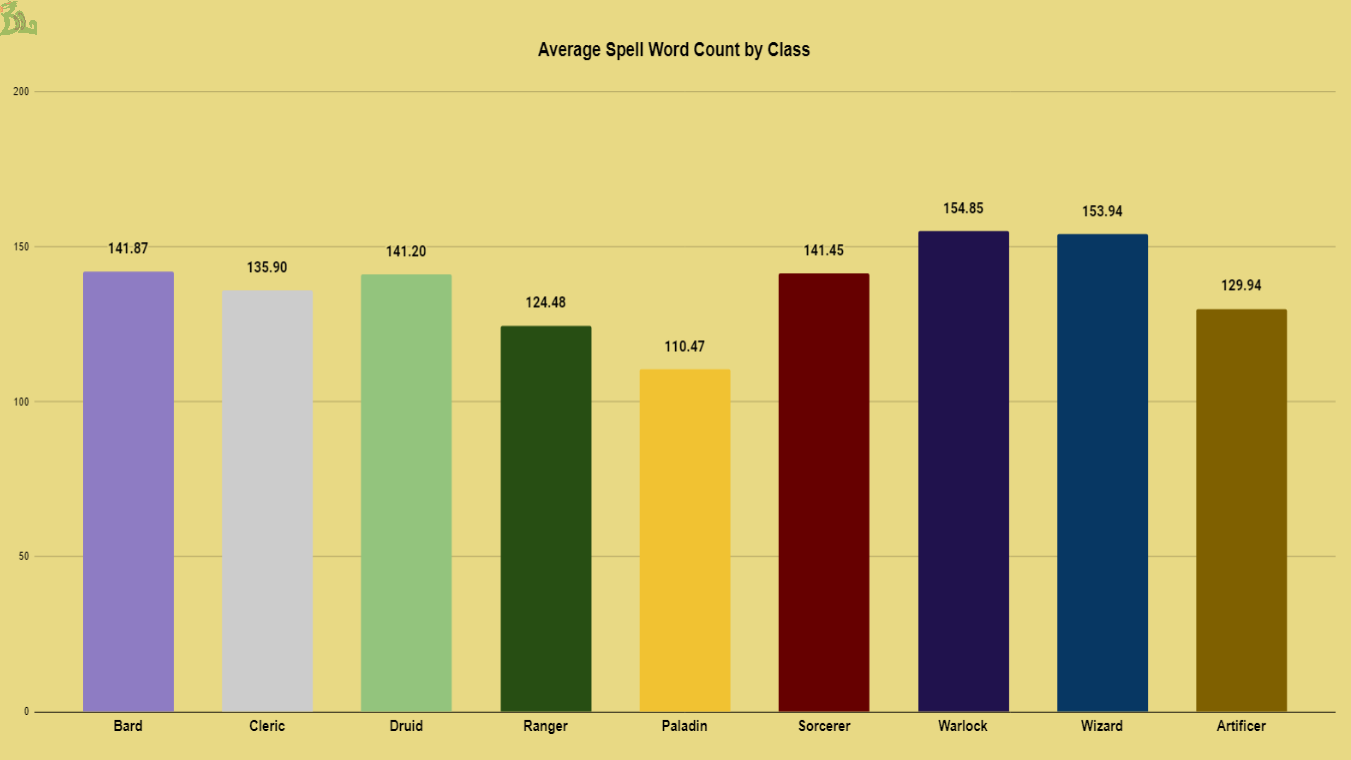
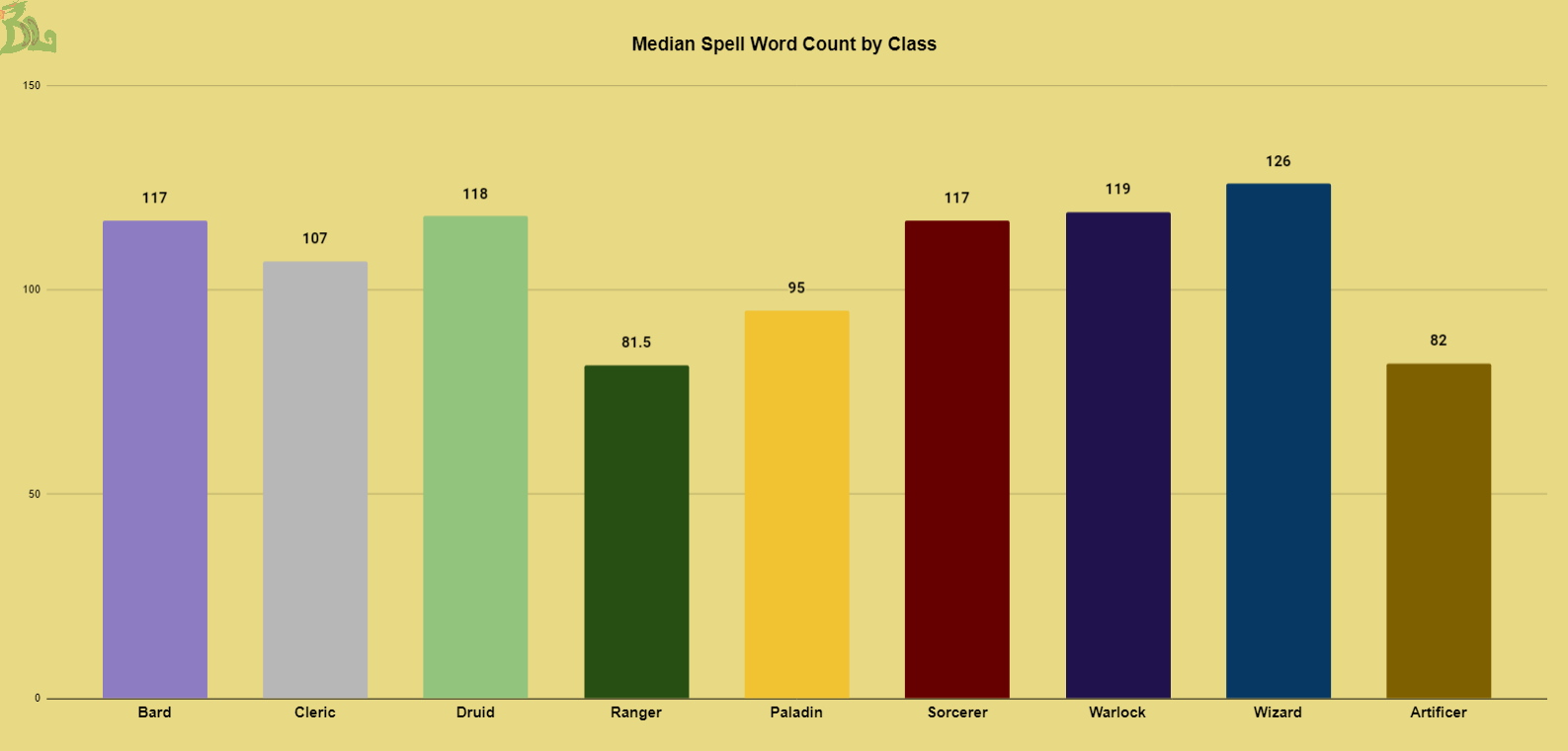
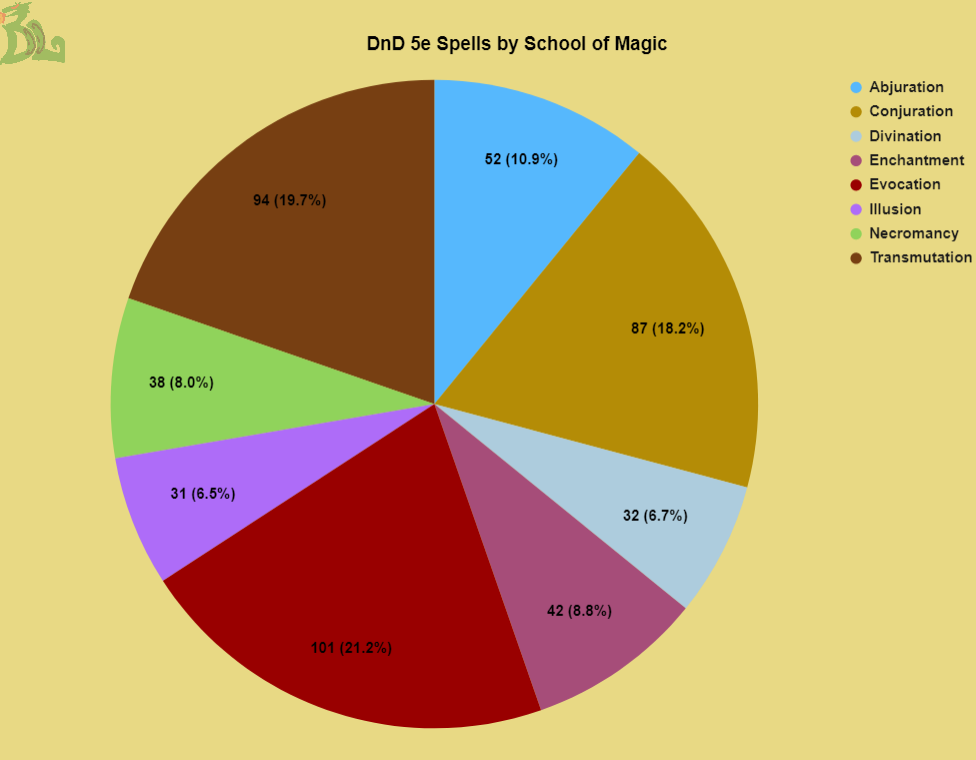
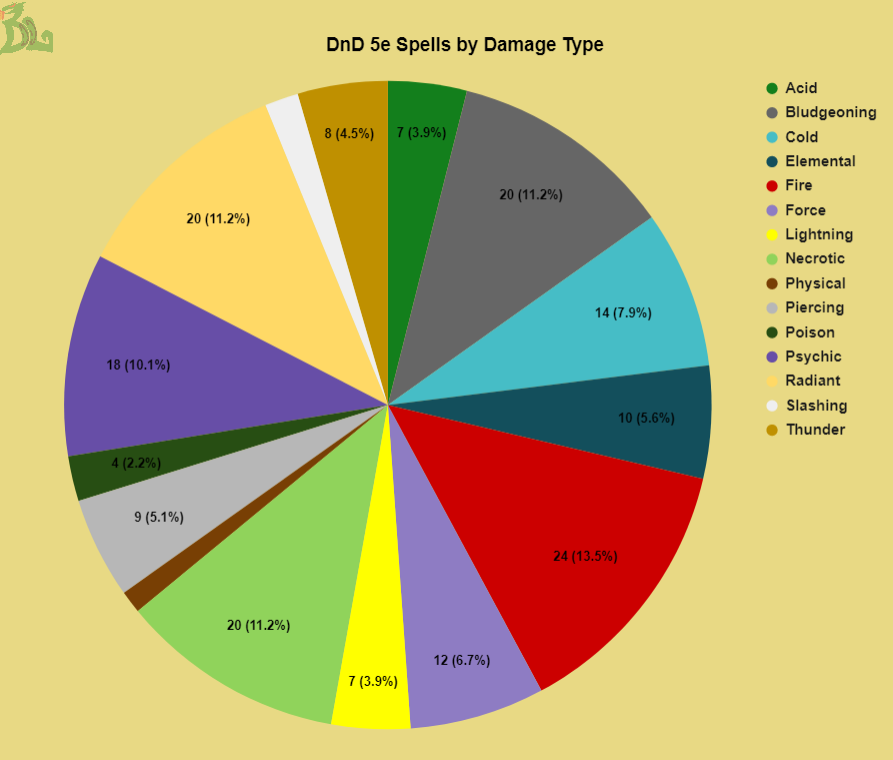
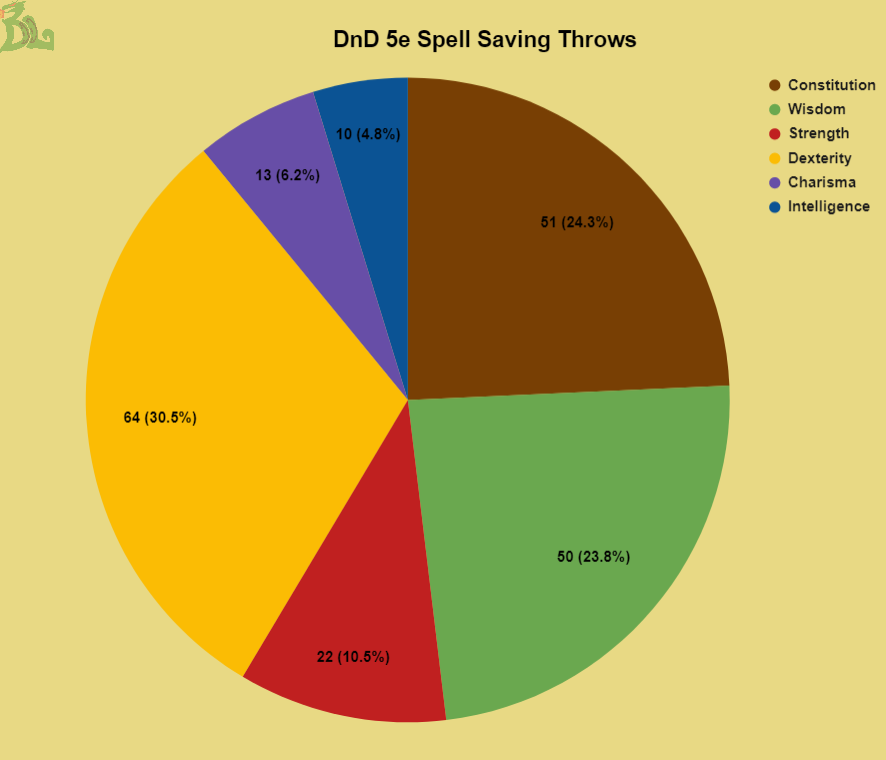
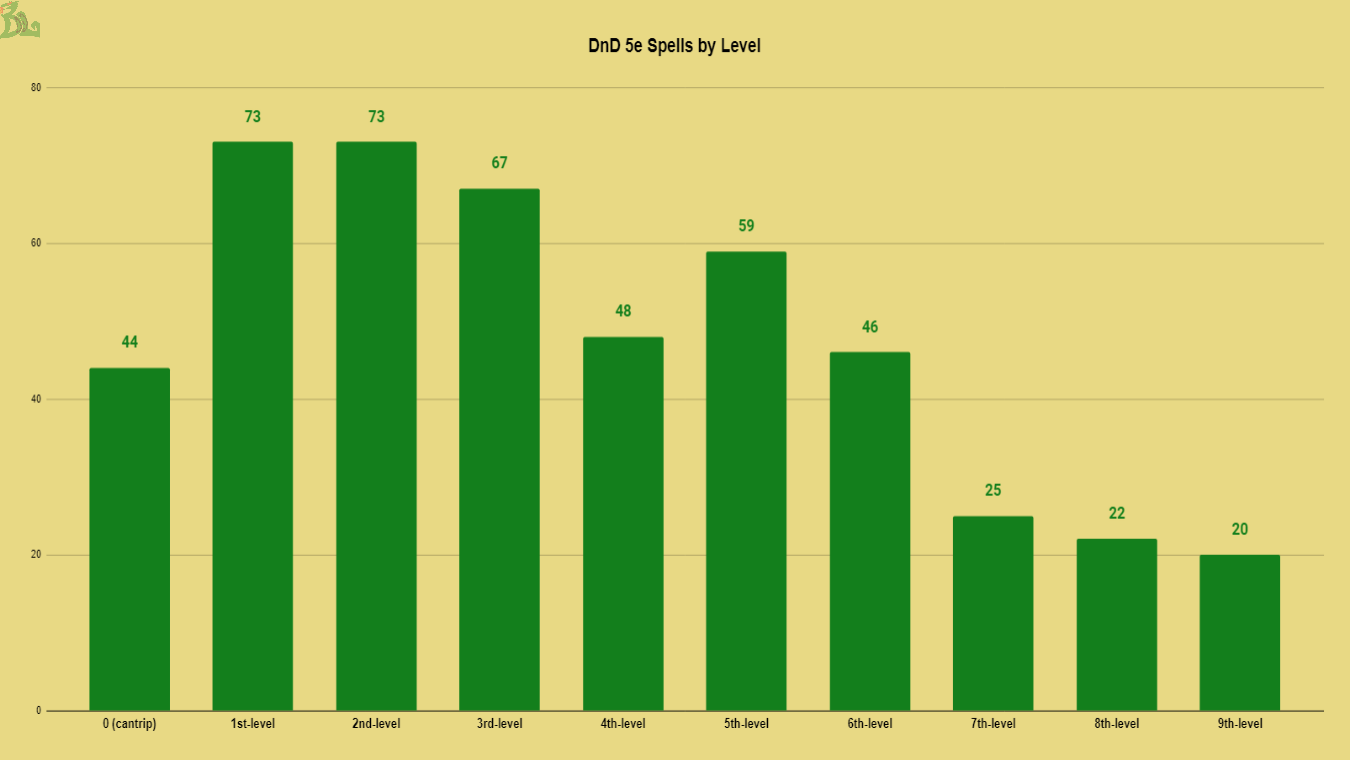
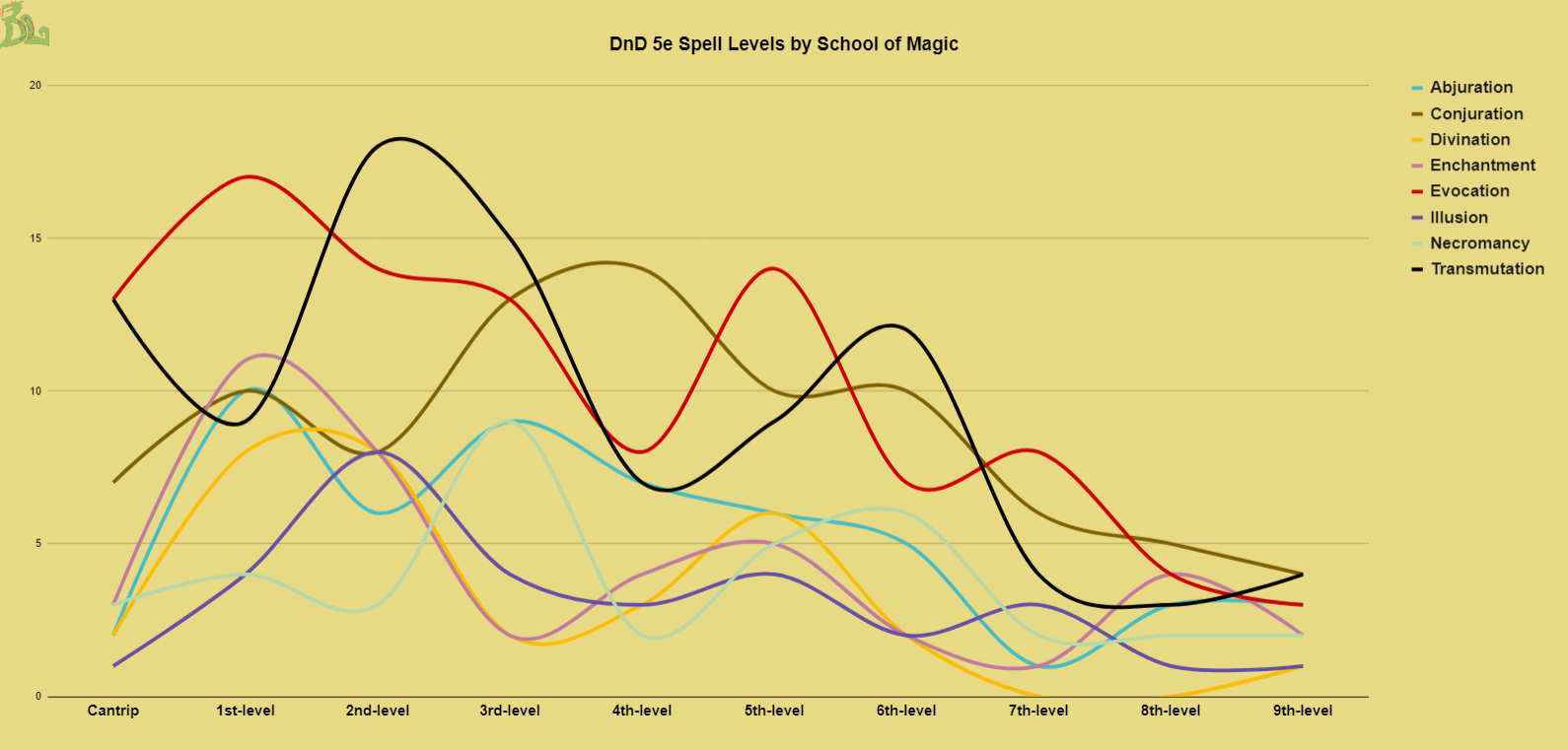
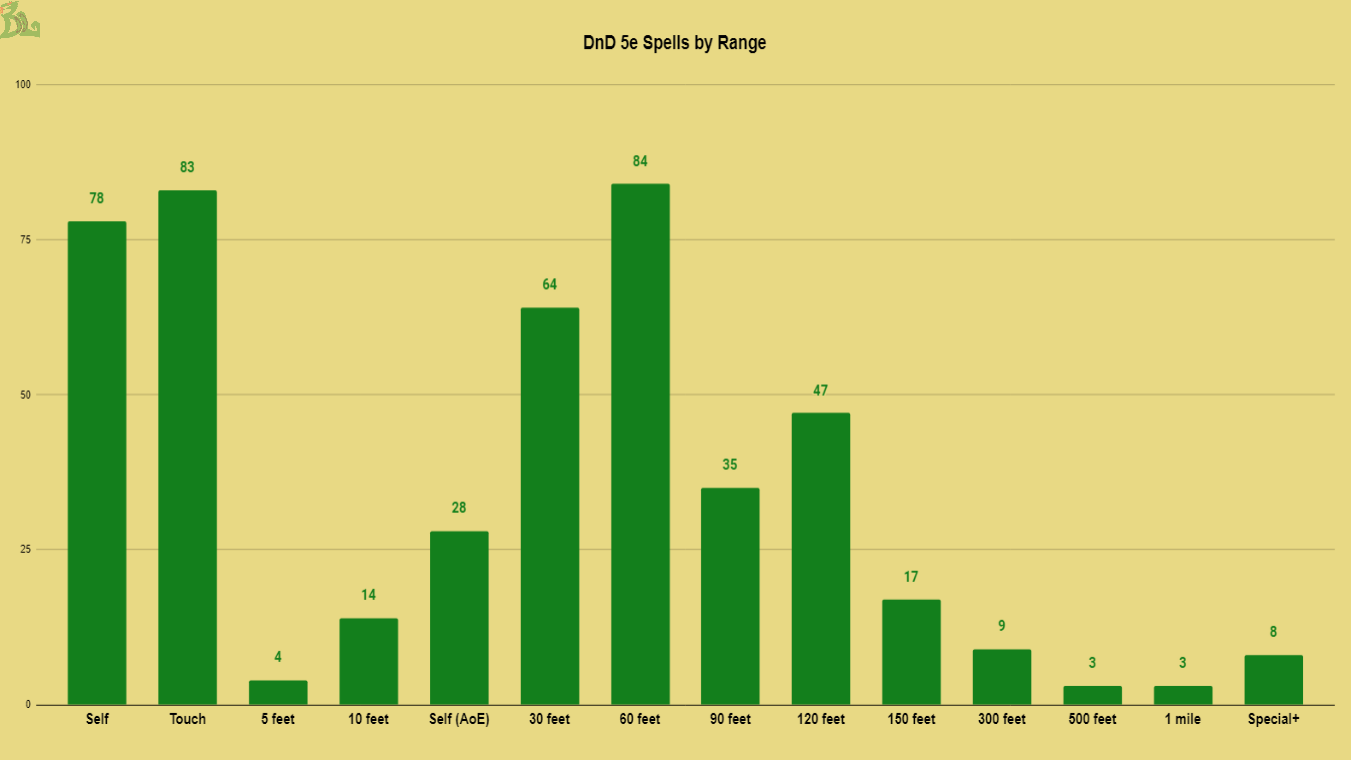
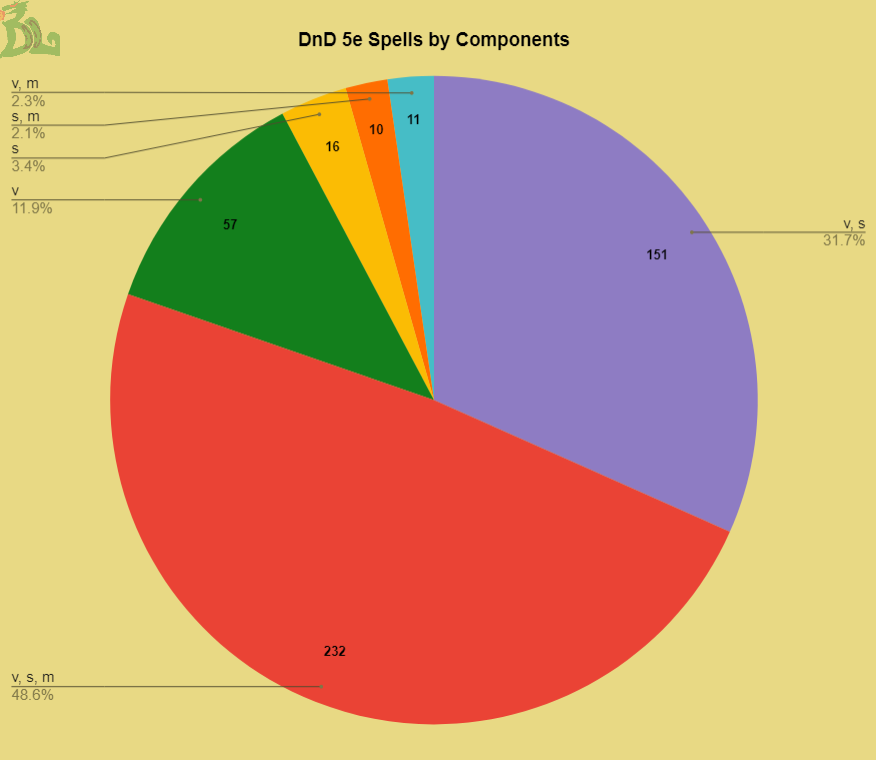
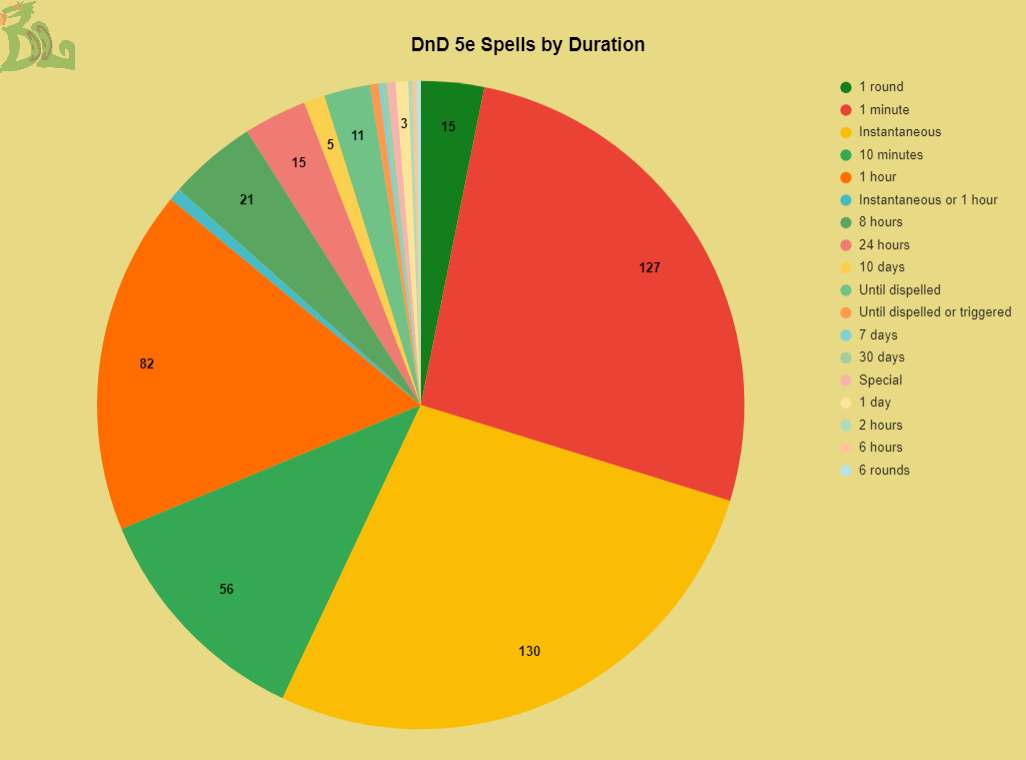
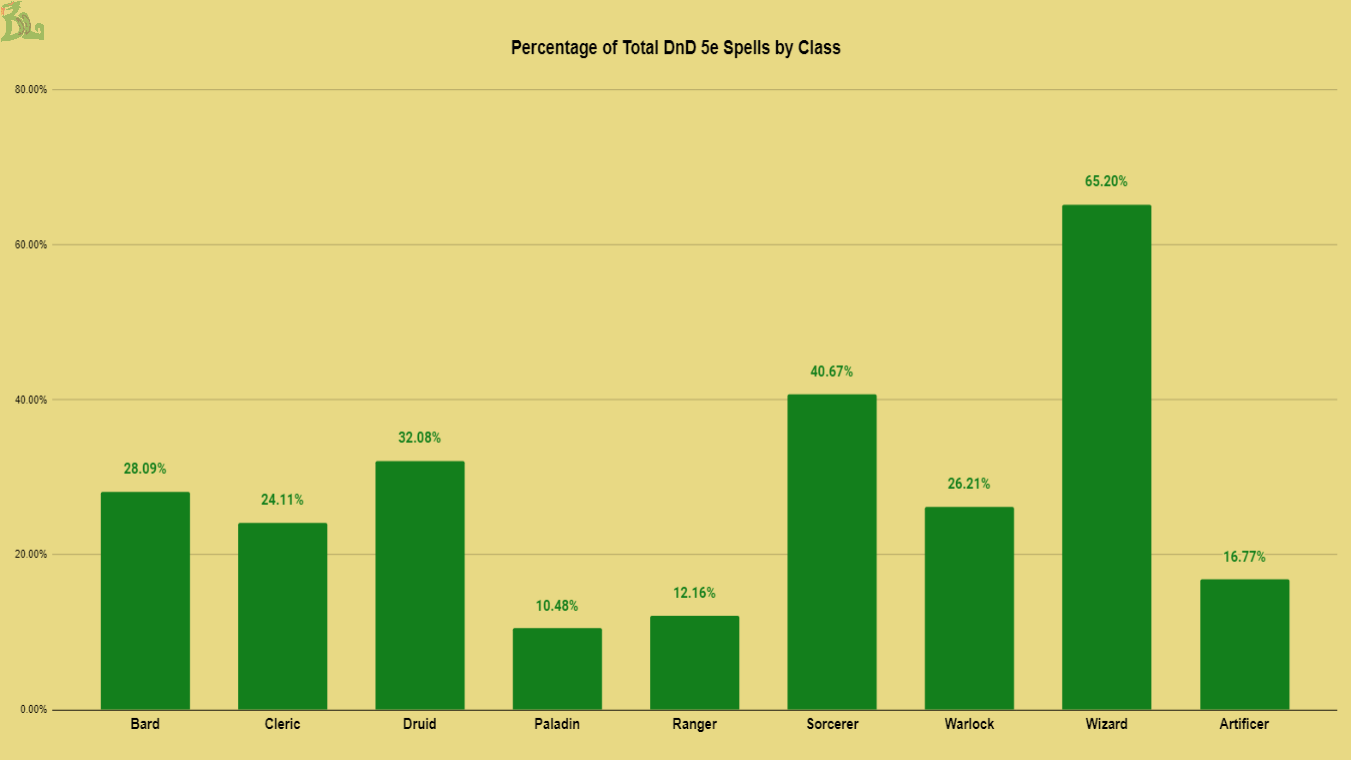
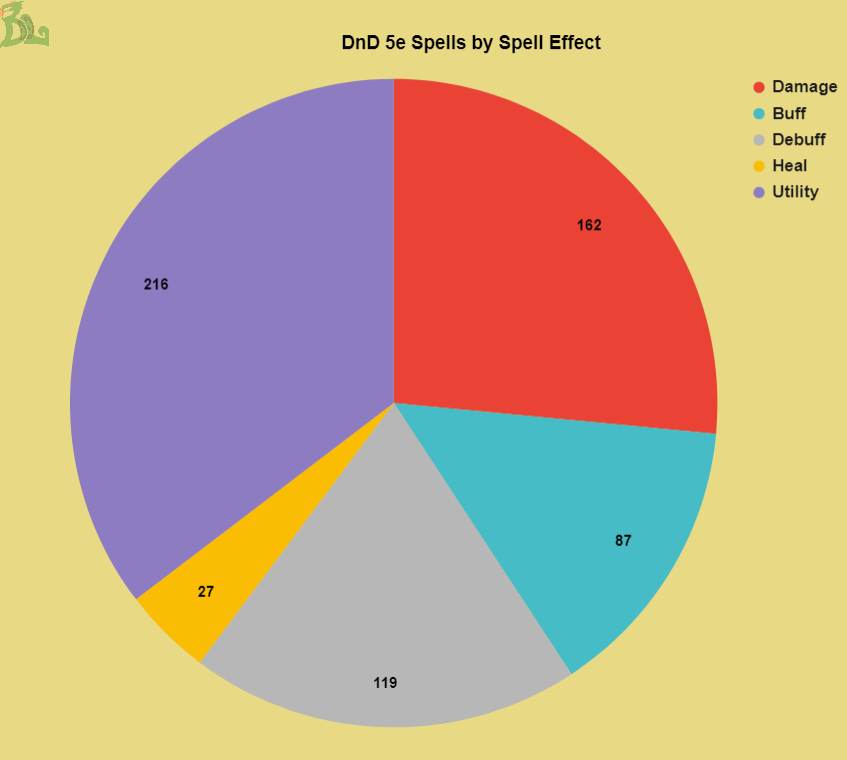
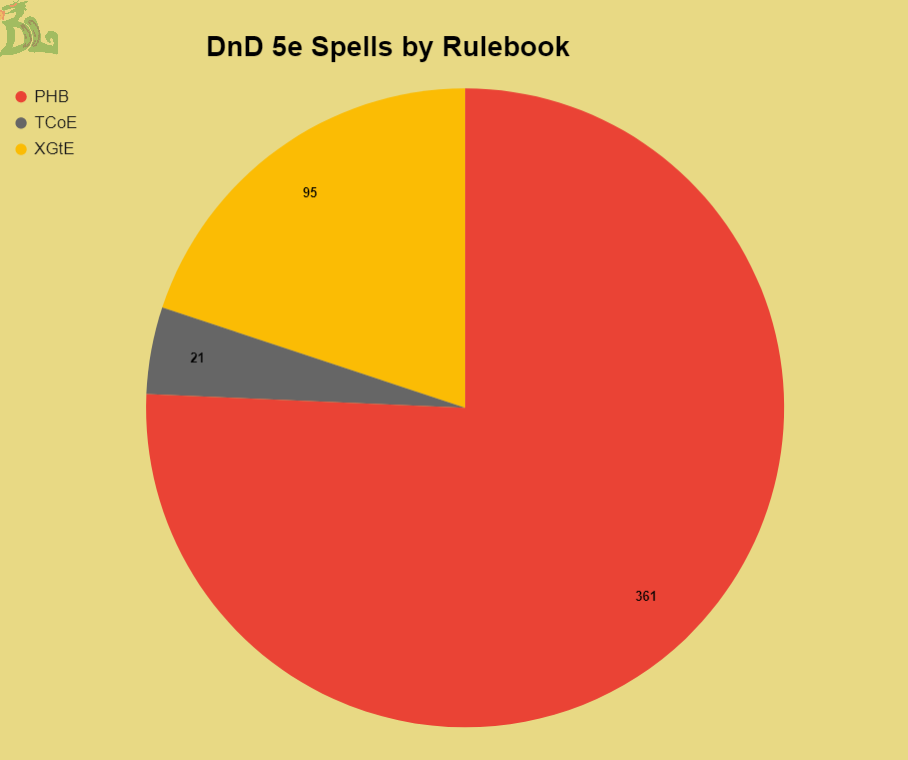
![Debuff Spells 5e [DnD Full List] dnd-ranger-casting-a-spell-on-spiders-5e](https://www.dndlounge.com/wp-content/uploads/2023/11/dnd-ranger-casting-a-spell-on-spiders-5e-300x169.webp)
![Healing Spells 5e [DnD Full List] dnd-elvish-druid-healing-human-fighter-5e](https://www.dndlounge.com/wp-content/uploads/2023/11/dnd-elvish-druid-healing-human-fighter-5e-300x169.webp)
![Buff Spells 5e [DnD Full List] dnd-tiefling-cleric-blesses-her-party-5e](https://www.dndlounge.com/wp-content/uploads/2023/11/dnd-tiefling-cleric-blesses-her-party-5e-300x169.webp)
![AoE Spells 5e [DnD Area of Effect + Multitarget Spells] dnd-dwarvish-wizard-casting-meteor-swarm-5e](https://www.dndlounge.com/wp-content/uploads/2023/11/dnd-dwarvish-wizard-casting-meteor-swarm-5e-300x169.webp)